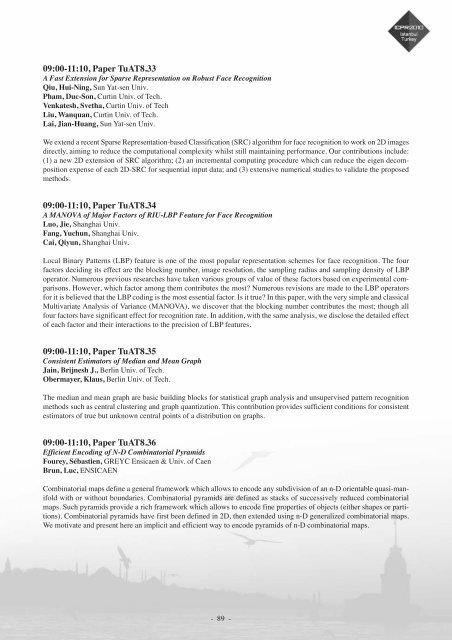Abstract book (pdf) - ICPR 2010
Abstract book (pdf) - ICPR 2010
Abstract book (pdf) - ICPR 2010
- TAGS
- abstract
- icpr
- icpr2010.org
Create successful ePaper yourself
Turn your PDF publications into a flip-book with our unique Google optimized e-Paper software.
09:00-11:10, Paper TuAT8.33<br />
A Fast Extension for Sparse Representation on Robust Face Recognition<br />
Qiu, Hui-Ning, Sun Yat-sen Univ.<br />
Pham, Duc-Son, Curtin Univ. of Tech.<br />
Venkatesh, Svetha, Curtin Univ. of Tech<br />
Liu, Wanquan, Curtin Univ. of Tech.<br />
Lai, Jian-Huang, Sun Yat-sen Univ.<br />
We extend a recent Sparse Representation-based Classification (SRC) algorithm for face recognition to work on 2D images<br />
directly, aiming to reduce the computational complexity whilst still maintaining performance. Our contributions include:<br />
(1) a new 2D extension of SRC algorithm; (2) an incremental computing procedure which can reduce the eigen decomposition<br />
expense of each 2D-SRC for sequential input data; and (3) extensive numerical studies to validate the proposed<br />
methods.<br />
09:00-11:10, Paper TuAT8.34<br />
A MANOVA of Major Factors of RIU-LBP Feature for Face Recognition<br />
Luo, Jie, Shanghai Univ.<br />
Fang, Yuchun, Shanghai Univ.<br />
Cai, Qiyun, Shanghai Univ.<br />
Local Binary Patterns (LBP) feature is one of the most popular representation schemes for face recognition. The four<br />
factors deciding its effect are the blocking number, image resolution, the sampling radius and sampling density of LBP<br />
operator. Numerous previous researches have taken various groups of value of these factors based on experimental comparisons.<br />
However, which factor among them contributes the most? Numerous revisions are made to the LBP operators<br />
for it is believed that the LBP coding is the most essential factor. Is it true? In this paper, with the very simple and classical<br />
Multivariate Analysis of Variance (MANOVA), we discover that the blocking number contributes the most; though all<br />
four factors have significant effect for recognition rate. In addition, with the same analysis, we disclose the detailed effect<br />
of each factor and their interactions to the precision of LBP features.<br />
09:00-11:10, Paper TuAT8.35<br />
Consistent Estimators of Median and Mean Graph<br />
Jain, Brijnesh J., Berlin Univ. of Tech.<br />
Obermayer, Klaus, Berlin Univ. of Tech.<br />
The median and mean graph are basic building blocks for statistical graph analysis and unsupervised pattern recognition<br />
methods such as central clustering and graph quantization. This contribution provides sufficient conditions for consistent<br />
estimators of true but unknown central points of a distribution on graphs.<br />
09:00-11:10, Paper TuAT8.36<br />
Efficient Encoding of N-D Combinatorial Pyramids<br />
Fourey, Sébastien, GREYC Ensicaen & Univ. of Caen<br />
Brun, Luc, ENSICAEN<br />
Combinatorial maps define a general framework which allows to encode any subdivision of an n-D orientable quasi-manifold<br />
with or without boundaries. Combinatorial pyramids are defined as stacks of successively reduced combinatorial<br />
maps. Such pyramids provide a rich framework which allows to encode fine properties of objects (either shapes or partitions).<br />
Combinatorial pyramids have first been defined in 2D, then extended using n-D generalized combinatorial maps.<br />
We motivate and present here an implicit and efficient way to encode pyramids of n-D combinatorial maps.<br />
- 89 -



